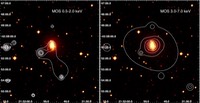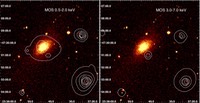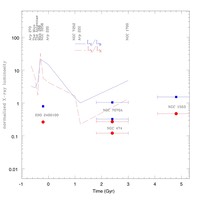The bulk of the ISM in early-type galaxies emits in X-rays, and only comparatively small quantities are detected in the warm and cold phase of the ISM (Bregman et al. 1992). The hot ISM is believed to build up primarily through stellar mass loss and Type Ia supernova ejecta. The two processes have an almost identical mass loss rate in metals although the SNIa ejecta are dominated by Fe. Humphrey & Buote (2006), using proper spectral fits to excellent Chandra data were able to better determine the metal abundances of the X-ray emitting gas for a sample of early-type galaxies. By estimating stellar abundances from optical line strength indices, adopting simple stellar population models, they showed that the hot ISM and stars have similar abundances.
The link between the stellar and ISM metallicities could be masked/contaminated by the accretion of a gas-rich system. Moreover, simulations of mergers (see e.g. Cox et al. 2006) or interactions (D'Ercole et al. 2000) of galaxies produce wide oscillations of the X-ray emission. In this context, the content of hot X-ray emitting gas could be correlated with the ``age'' of possible rejuvenation in the stellar population triggered by accretion episodes. Early-type galaxies with fine structure, e.g. shells, which are considered bona fide signatures of the ``dynamical youth'' of the galaxy, tend to be less X-ray luminous than more relaxed, ``mature'' ellipticals with little evidence of fine structure. These are also characterized by extended, and generally stronger, X-ray emission (Sansom et al. 2000). One extreme example, NGC 474, that shows a well developed shell system, has an X-ray luminosity consistent with the low end of the expected emission from discrete sources (Rampazzo et al. 2006). The X-ray domain may further disclose an otherwise hidden AGN activity, that could also be a result of the merging episodes. Again an extremeexample of nuclear activity in a merger remnant can be found in the newly discovered spectacular shell system in the elliptical host of the QSO MC2 1635+119 by (Canalizo et al. 2007).
So, whereas accretion/merging events are widely believed to be at the origin of shell galaxies, all the details such as: the age of the event and duration of the shell structure, the global secular evolution of the stellar and gas components of the host galaxy as well as the timing for triggering the AGN, its duty cycle and feedback, are far from being firmly established. In light of the high fraction of shell galaxies in the field, interaction/accretion/merging events seem to have played a significant role in the evolution of the early-type class as a whole. At the same time, there is still the general open question of whether a link exists between shell galaxies and the early phases of merging processes (ULIRGs, AGN, E+A galaxies etc.) on one side and the general class of ``normal'' early-type galaxies on the other.
In the above framework, we discuss the X-ray (XMM-{\it Newton}) observations of two shell galaxies, NGC~7070A and ESO~2400100, taken from the Malin & Carter (1983) compilation. We further present far UV XMM-Newton Optical Monitor observations of these objects, and we add GALEX far UV observations of NGC 474, for which the results from XMM-Newton X-ray observations have been already presented in Rampazzo (2006). Through far UV photometry we aim at inferring whether these galaxies have ongoing/recent star formation activity and its distribution across the galaxy. We finally aim to correlate the above information with those extracted from their hot gas content and properties in light of our current understanding of these components.
Results The X-ray spatial and spectral analysis show significant differences in the two objects. A low luminosity nuclear source is the dominant component in NGC 7070A (log LX=41.7 erg s-1 in the 2-10 keV band). In ESO 2400100, the X-ray emission is due to a low temperature plasma with a contribution from the collective emission of individual sources. In the Optical Monitor image ESO 2400100 shows a double nucleus, one bluer than the other. This probably results from a very recent star formation event in the northern nuclear region. The extension of the UV emission is consistent with the optical extent for all galaxies, at different degrees of significance in different filters. The presence of the double nucleus, corroborated by the (UV - optical) colors and line strength indices analysis, suggests that ESO 2400100 is accreting a faint companion. We explore the evolution of the X-ray luminosity during accretion processes with time. The presence of gas might be linked with age, since it is detected either before coalescence or several Gyr (>3) after.
more details in Trinchieri G., Rampazzo R., Chiosi C., Grutzbauch R., Marino A., Tantalo R.
XMM-Newton X-ray and Optical Monitor far UV observations of NGC 7070A and ESO 2400100 shell galaxies
2008, A&A, 489, 85


